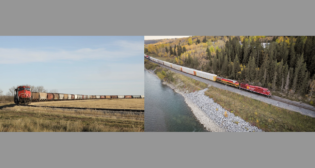
IAROO, ABA provide BNSF 90 CFM Test Waiver update
Written by Carolina Worrell, Senior EditorThe International Association of Railway Operating Officers, Inc. (IAROO) and the Air Brake Association (ABA) held a joint session on Oct. 5, 2015 at Railway Interchange 2015 in Minneapolis, Minn., to discuss the BNSF 90 CFM pilot test waiver.
Jeff Garrels, Director of Train Handling at BNSF explained that the need to increase from 60 CFM to 90 CFM – DP (distributed power) operations is specifically for cold weather such as on the railroad’s Northern Hi-Line route—Minneapolis to Whitefish, Mont.
Present day Federal Railroad Administration (FRA) and previous Transport Canada Air Brake Rules include:
• Limit the air flow not to exceed 60 CFM for an entire train/combined DP
• No more than 15 psi brake pipe pressure gradient between head-end and rear-end.
• These requirements have been in place since 1984 in Canada and 1989 in the U.S.
Operations under waiver:
• Limit air flow to not exceed 90 CFM combined on DP trains when meeting established criteria.
According to BSNF, one advantage of DP is “the ability to charge and maintain brake pipe by multiple air sources, distributed throughout the train.”
In 2009, CP and CN began testing 90 CFM, which was then approved in Canada in November 2011. Calculating data from the Canadian railroads, BNSF began its 90 CFM Waiver testing in Great Falls, Mont. in August 2012.
90 CFM Waiver testing exhibited the following results and observations:
• Did not adversely affect LOCOTROL® Communication Interruption recovery protocols.
• Did not have any negative impacts on overall air brake functionality of train brakes under certain conditions of DP and train segment lengths.
• As temperature decreases, flow increases. Specifically seen at temperatures below 0 degrees.
• No difference in BP performance across various train types.
• Brake applications and releases ranging from a minimum reduction to a full service application were made without any problems at brake pipe leakeage rates of 60 CFM and 90 CFM.
• No significant differences were noted between the brake applications made at 90 CFM versus the brake applications made at 60 CFM or in between.
• Several trains did exceed the 90 CFM but were secured till flow resided. “Testing conducted thus far has validated our theory that air flow rates can be increased from today’s maximum of 60 CFM to reach as high as 90 CFM combined on distributed power trains and still allow continued safe train operations,” BSNF said.
BNSF’s next steps included providing a waiver update to FRA and in September 2015, the railroad submitted to FRA for admission to docket. In addition, a Waiver Subcommittee has been formed to assist and the Association of American Railroads (AAR) is helping to facilitate the process.
Steven Zuiderveen, Railroad Safety Specialist, FRA, says the railroad industry may petition for rulemaking by following the process in Part 211 of Title 49 of the Code of Federal Regulations (49 CFR Part 211).
The test waiver, BNSF says, has been extended until 2017 and in the interim the railroad will “continue to operate under the waiver in place as it offers operational benefits during cold weather. “
The waiver committee/subcommittee is actively working with AAR to finalize petition for proposed change in regulation and its subsequent submission to the FRA, BNSF adds.



